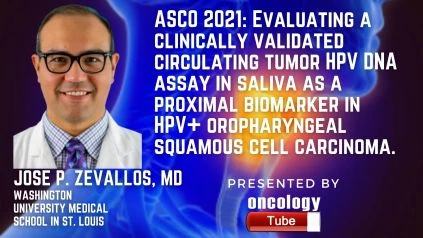Jose P. Zevallos, MD, MPH, FACS, Associate Professor Otolaryngology-Head and Neck Surgery; Chief Head & Neck Oncologic Surgery at the Washington University Medical School in St. Louis speaks about the ASCO 2021 Abstract – Evaluating a clinically validated circulating tumor HPV DNA assay in saliva as a proximal biomarker in HPV+ oropharyngeal squamous cell carcinoma. Sophie P. Gerndt, MD author of the upcoming manuscript.
Link to Abstract:
https://meetinglibrary.asco.org/record/197768/abstract
Background:
HPV genomic DNA has been investigated extensively in plasma and saliva, but circulating tumor human papillomavirus DNA (ctHPVDNA) has just emerged as a reliable biomarker for monitoring in HPV+ oropharyngeal squamous cell carcinoma (OPSCC). Tumor-derived viral DNA (tumor-tissue modified viral DNA, or TTMV) is distinguished from other non-cancer linked sources of HPV DNA by a commercial assay for this biomarker. This method has previously been discussed in the context of plasma, but its value in the saliva is currently unclear.
Methods:
46 individuals with HPV+ OPSCC with linked pre-treatment plasma and saliva samples were identified using a prospectively collected and banked biospecimen repository. All frozen plasma and saliva samples were tested for DNA integrity and TTMV using a clinically approved ddPCR-based assay (NavDxTM; Naveris Inc, Natick, MA) to quantify TTMV for HPV-16, -18, -31, -33, and -35. Clinical and pathological data were collected by a retrospective chart review. For statistical analysis, Graphpad was employed. TTMV copies in saliva and plasma were correlated using Spearman’s r. To compare sample types, the Wilcoxon test was utilized. For categorical variables, the Mann-Whitney test was utilized.
Results:
In 43 of 46 plasma samples and 44 of 46 saliva samples, TTMV DNA was found. One plasma sample failed quality control, one sample of each type showed undetectable TTMV, and one sample of each type was indeterminate. There were 38 (93%) men among the 41 evaluable patients with matched samples, 36 (88%) were stage I-II, 5 (12%) were stage III-IV (AJCC 8th, clinical staging), and 25 (61%) had a history of smoking with a median of 37.5 pack years. With median copy numbers of 14,139 copies/ml (IQR=193,339.5) and 774.7 copies/ml (IQR=4,826.1), respectively, TTMV was substantially enriched in saliva compared to plasma (p0.0001). Plasma and saliva TTMV levels had a substantial positive connection (r=0.344, p=0.028). In terms of overall stage, neither specimen type differed. Among all sample types, there was a trend toward increased TTMV in individuals who had smoked before. In the final group, 38 (93%) of the patients had a pack-year history. Plasma TTMV neared significance (p=0.058) when grouped by pack-years, however high saliva TTMV was substantially linked with >10 pack-year history (p=0.011).
Conclusions:
This is the first study to show that tumor-tissue transformed HPV DNA can be quantified in saliva. Pre-treatment saliva samples had considerably greater amounts of TTMV than plasma samples. TTMV separates ctHPVDNA from HPV DNA from other sources. These findings point to the possible utility of TTMV detection in saliva for early identification of HPV+ OPSCC, as well as its potential function in post-treatment local monitoring. To fully understand the impact of smoking on TTMV levels, more study is required.

